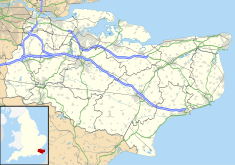
Barry Council Office and Library is a local government building and public library located in King Square, Barry, Wales. The building, which was once the meeting place of Barry Municipal Borough Council, is a Grade II listed building.

Bournemouth Town Hall, also known as the Civic Centre and formerly the Mont Dore Hotel, is a municipal facility in Bourne Avenue, Bournemouth, England. The town hall, which is the meeting place of Bournemouth, Christchurch and Poole Council, is a Grade II listed building. The town hall stands opposite Bournemouth Gardens and the Bournemouth War Memorial and is adjacent to St. Andrew's Church, Richmond Hill.

Wells Town Hall is a municipal building in the Market Place in Wells, Somerset, England. The building, which is the headquarters of Wells City Council, is a Grade II listed building.

Farnham Town Hall is a municipal building in South Street, Farnham, Surrey, England. It provides the offices and the meeting place of Farnham Town Council.

Whitehaven Town Hall is a municipal building in Duke Street in Whitehaven, Cumbria, England. The building, which was the headquarters of Whitehaven Borough Council, is a Grade II listed building.

Godalming Borough Hall is a municipal building in Bridge Street in Godalming, a town in Surrey, England. The building was the meeting place of Godalming Town Council.

The Municipal Buildings are based in Corn Exchange Road, Stirling, Scotland. The structure, which was the meeting place of Stirling Burgh Council, is a Category B listed building.

Great Torrington Town Hall is a municipal building in the High Street, Great Torrington, Devon, England. The town hall, which is the meeting place of Great Torrington Town Council, is a Grade II listed building.
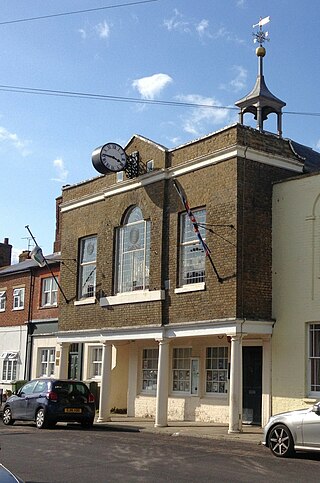
Queenborough Guildhall is a former municipal building in the High Street in Queenborough, Kent, England. The structure, which is currently used as a museum, is a Grade II listed building.
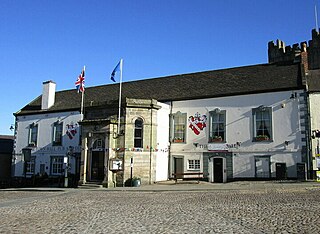
Richmond Town Hall is a municipal building in the Market Place, Richmond, North Yorkshire, England. The structure, which is the meeting place of Richmond Town Council, is a grade II listed building.

Wallingford Town Hall is a municipal building in the Market Place in Wallingford, Oxfordshire, England. The building, which is the meeting place of Wallingford Town Council, is a Grade I listed building.

Bishop's Castle Town Hall is a municipal building in the High Street in Bishop's Castle, Shropshire, England. The building, which is the meeting place of Bishop's Castle Town Council, is a Grade II* listed building.
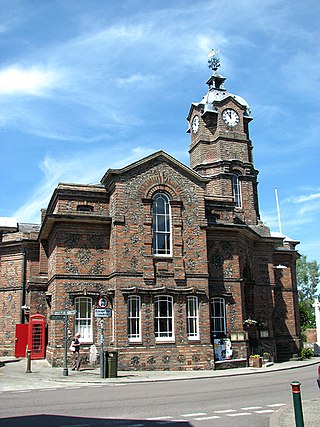
Eye Town Hall is a municipal building in Broad Street in Eye, Suffolk, England. The building, which is the meeting place of Eye Town Council, is a Grade II* listed building.

The Old Town Hall is a municipal building in the Market Place in Wilton, Wiltshire, England. The structure, which is currently used as a Baptist church, is a Grade II listed building.

Welshpool Town Hall, is a municipal building in Broad Street, Welshpool, Powys, Wales. The structure, which is the meeting place of Welshpool Town Council, is a Grade II listed building.

Brecon Guildhall, is a municipal building in the High Street, Brecon, Powys, Wales. The structure, which is the meeting place of Brecon Town Council, is a Grade II listed building.

The Moot Hall is a municipal building in Boroughgate, Appleby-in-Westmorland, Cumbria, England. The building, which is currently used as the meeting place of Appleby-in-Westmorland Town Council, is a Grade II* listed building.

Higham Ferrers Town Hall is a municipal building in the Market Square in Higham Ferrers, Northamptonshire, England. The structure, which serves as the offices and meeting place of Higham Ferrers Town Council, is a Grade II listed building.
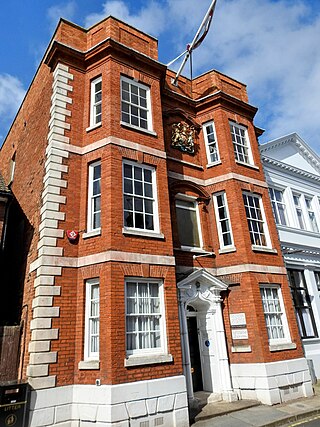
Harwich Guildhall is a municipal building in Church Street, Harwich, Essex, England. The structure, which accommodates the offices of Harwich Town Council, is a Grade I listed building.

Gravesham Civic Centre is a municipal building in Windmill Street in Gravesend, a town in Kent, in England. The building accommodates the offices and meeting place of Gravesham Borough Council.

